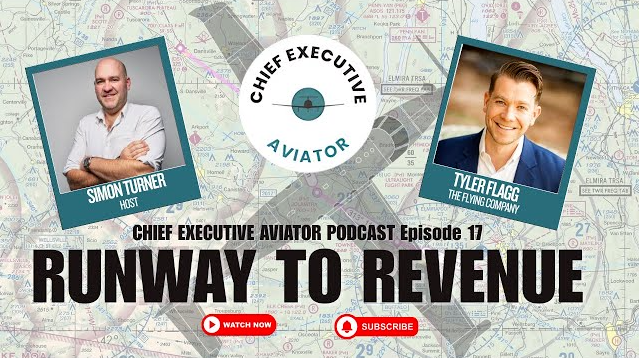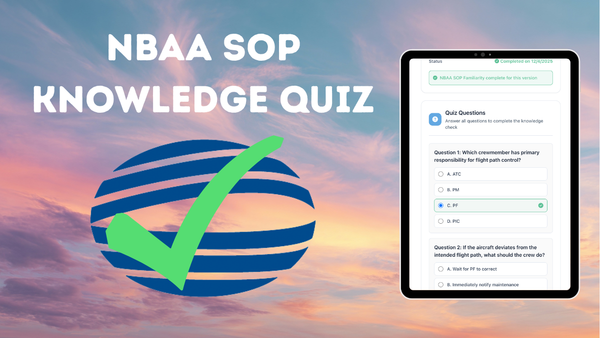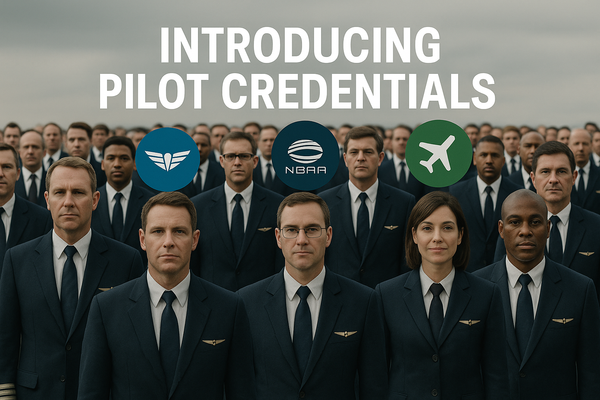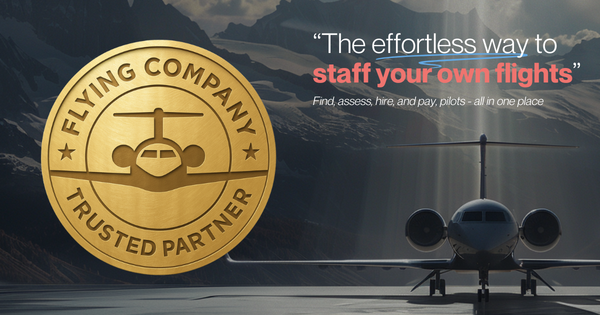Chief Executive Aviator Pod x Flying Company's Tyler Flagg

Recently, I sat down with Simon Turner on the Chief Executive Aviator Podcast to talk about my journey — from growing up in a family of actors, to serving 14 years in the Air Force, to flying corporate jets, and now building Flying Company.
It was a wide-ranging conversation, but at the heart of it was something that matters deeply to me: solving real problems for aircraft owners and operators. Flying Company exists to make it simple to find, assess, manage, hire, and pay pilots — all in one place.
Falling into Aviation
I always laugh when I tell my aviation story because I didn’t grow up dreaming of being a pilot. My family was full of actors, and I figured I’d follow that path in some way. After 9/11, though, I decided I wanted to serve. My mom convinced me to pursue a commission instead of enlisting, so I went to ROTC through an Air Force scholarship.
Flying wasn’t even on my radar until someone at my detachment asked if I’d put in for a pilot slot. When I said no, she told me: “If you put your name in, you’ll get it.” So, I did. And that decision changed the course of my life.
I trained with the Navy in the T-34 and then transitioned to the Beechjet 400 (the T-1 in Air Force terms). My first assignment was with a special operations squadron flying small teams of SEALs, Rangers, and Green Berets wherever they needed to go. It was a unique mission that had me deployed six times, flying in 67 different countries.
Lessons from the Military
That first squadron felt a lot like a startup. The unit was brand new, we had just bought our first aircraft, and nobody really knew what they were doing yet. It was chaotic, but it forced us to figure things out quickly and deliver value to the end user — in our case, the special operations teams.
That experience stuck with me. While the military as a whole is the world’s largest bureaucracy, that squadron taught me how to build in an environment where resources are scarce and outcomes matter. Many of my peers from that time have since gone on to launch startups of their own.
Transitioning into Business Aviation
After leaving the Air Force, I started flying a Pilatus PC-24 in Bentonville, Arkansas. I loved the flying, but stepping into the chief pilot role in Part 91 operations was trial by fire. Insurance requirements, taxes, maintenance, LOAs, accounting — I had to teach myself all of it while keeping the airplane flying.
One of the biggest headaches was sourcing contract pilots. Early on, my insurer wouldn’t cover single-pilot ops in the PC-24, so I needed a second pilot for almost every trip. The process was painful:
- Calling or texting every pilot I knew
- Digging through Facebook and WhatsApp groups
- Sending pilot history forms back and forth with brokers
- Waiting days for responses
- Getting approvals from insurance
- Finally syncing with accounting to pay people
Each trip easily cost me 6–7 hours of administrative work. And the whole time, I was stressed about whether it would all come together in time.
That frustration was the spark for Flying Company.
Why Flying Company Exists
Flying Company is, in simple terms, Care.com for aviation. It’s a marketplace built specifically for contract pilots and the operators who need them. But more than that, it’s the connective tissue — the software layer — that makes hiring, flying, and paying pilots seamless.
Here’s what the platform does today:
- Pilot profiles standardized with certificates, hours, ratings, and type ratings.
- Downloadable Pilot History Forms accepted by insurance brokers.
- Aircraft and trip profiles operators can create in minutes.
- Quote dashboard to compare pilots’ rates and expenses.
- FAA verification built right into pilot profiles.
- Pilot Services Agreement signed digitally at the time of hire.
- Payments through Stripe, with matching invoices and automated 1099s.
Instead of wasting days on logistics, operators can handle everything in under 30 minutes.
The Bigger Picture
What struck me while building this is how far behind aviation is compared to other industries. Doctors, lawyers, truckers, and skilled trades all have staffing marketplaces. But pilots — some of the most highly credentialed professionals in the world — didn’t.
That gap creates a huge opportunity. Business aviation is already built on the principle of valuing time. If we can save operators hours of wasted effort while giving pilots better access to opportunities, everyone wins.
Joining Forum Ventures
This year I joined Forum Ventures, a B2B SaaS accelerator. I applied intentionally because while I understand aviation and people, I’d never built SaaS before. Forum has helped me refine Flying Company into not just a marketplace, but a software platform with real value in the connective tissue between pilots and operators.
That support has been huge as we expand. We launched with Pilatus, and now with the Citation Jet Pilots (CJP) association. The response at their convention in San Antonio was incredible — owners and chief pilots immediately recognized how much time and stress this could save.
What’s Next
The roadmap is exciting:
- AI-powered matching based on logbook data and airport experience.
- Seamless logbook integration to speed up pilot onboarding.
- Better insurance alignment to reduce friction.
- Management company tools for scaling across fleets.
And that’s just the beginning. Every week, pilots and operators send me new ideas that could make the platform even better. I’m committed to listening and building features that save time, reduce risk, and make aviation easier.
Closing
I’m grateful to Simon and the Chief Executive Aviator Podcast for the chance to share my story. If you’d like to listen to the full conversation, you can find it here.
And if you’re an aircraft owner, operator, or pilot — or even just curious about the future of business aviation staffing — check out flyingcompany.com. I’d love your feedback.
— Tyler Flagg




